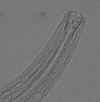- Lips usually fused..
- Large cylindrical buccal cavity, usually with 3 immovable teeth of unequal size surounded in the psoterior region by esophageal tissue
- Esophageal glamds open through the teeth.
- Amphidial fovea pocket-shaped, posterior to buccal cavity.
- Esophagus muscular throughout length, esophageal gland openings just posterior to buccal cavity.
- Males mainly diorchic, spicules varied in shape and size; gubernavulum present or absent.
- Females didelphic amphidelphiuc or monodelphic prodelphic; ovaries reflexed.
Ref: Smol et al 2013
The Oncholaimidae has more than 300 species and is one of the largest families of the Class Enoplida. The species are widespread in the seas and oceans of the world, especially in intertidal regions and the upper part of the sublittoral regions. They also occur in freshwater lakes, rivers and even underground waters.
The Oncholaimidae can be represented as seven subfamilies:
- Adoncholaiminae
- Krampiinae
- Octonchinae
- Oncholaimellinae De Coninck, 1965
- Oncholaiminae Filipjev, 1916
- Pelagonematinae
- Pontonematinae
The subfamilies are differentiated by features such as the number and length of teeth, the position of the largest tooth, the structure of the female reproductive system, and the presence and development of the demanian system (Smol & Coomans, 2006; Smol et al., 2014).
The Demanian system is a set of canals, junctions and pores unique for some genera of Oncholaimidae. The system differs from simple (primitive) to more complex (advanced) in different genera and species. The Demanian system features in "traumatic insemination" in which the male uses spicules and secretions to puncture the cuticle of the posterior of the female to form a copulatory pore. Sperm are released into the pore. The sperm injected into the female move through terminal ducts and reach the main duct of the Demanian system. The sperm move forward in the main duct to the uterus through the uvette and ductus uterinus. Eggs are fetrilized in the uterus ( Coomans et al., 1988; Tchesunov, 2015).

Oncholaomidae - anterior